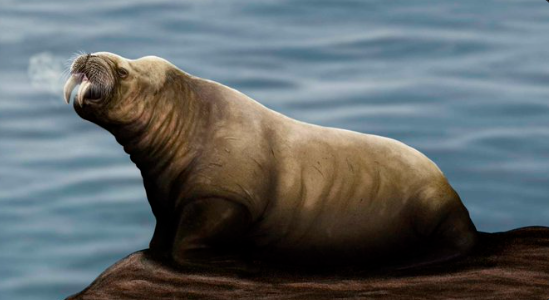Cool Facts about Ontocetus emmonsi:
- Size and Appearance: Ontocetus emmonsi was significantly larger than modern walruses, with some estimates suggesting it could reach lengths of up to 4 meters (about 13 feet). It had elongated tusks similar to those of modern walruses, which it likely used for defense, dominance displays, or possibly for digging in the seabed for food.
- Distribution: Fossils of Ontocetus emmonsi have been found in various locations across the northern hemisphere, particularly along the coasts of North America and Japan, indicating that this species had a wide geographic range.
- Diet: Like modern walruses, Ontocetus emmonsi was likely a carnivorous marine mammal, feeding primarily on mollusks, fish, and other marine organisms. Its robust teeth and jaws suggest it was well-adapted to crushing hard-shelled prey.
- Evolutionary Significance: Ontocetus emmonsi provides important insights into the evolution of pinnipeds (the group that includes seals, sea lions, and walruses). Its fossils help paleontologists understand the adaptations that occurred as these animals transitioned from land to sea.
- Extinction: Ontocetus emmonsi went extinct around the end of the Pleistocene, possibly due to changes in sea levels and climate that affected its habitat and food sources. This extinction coincided with the disappearance of many other large marine mammals.
A remarkable discovery has revealed a new prehistoric mammal species that shares fascinating similarities with the modern walrus. This fossil, dating back between 1.7 to 2.2 million years, was unearthed from the Lower Pleistocene layers in the North Atlantic, offering new insights into the evolution of marine mammals.
Meet Ontocetus posti 🦭 a new species of odobenines we described in a new study led by @MathBoisville based on material from the UK & Belgium 🇬🇧🇧🇪 Want to know more about this new fossil walrus? Here is a thread 🧵1/7. 🎨by @BranArtworks https://t.co/qZvEZvZoCX pic.twitter.com/1TyjznqS8d
— Narimane Chatar (@NarimaneChatar) August 13, 2024
The discovery, led by a team of paleontologists under the guidance of Mathieu Boisville from the University of Tsukuba in Japan, has brought to light a previously unknown species. This species, now named Ontocetus posti, shows striking parallels to the modern walrus, particularly in its feeding habits.
The newly identified species has caught the attention of the scientific community due to its unique feeding technique, which bears a close resemblance to that of today’s walruses (Odobenus rosmarus). Boisville explained that Ontocetus posti is closely related to the modern walrus, particularly in its use of suction-feeding—a specialized method that allows the walrus to efficiently extract food from its prey.
Ontocetus posti was equipped with four post-canine teeth, a larger lower canine, and a fused, shorter jaw—features that closely mirror those of its modern relatives. These physical characteristics suggest that Ontocetus posti was also a suction feeder, albeit less specialized than today’s walruses.
Modern walruses have perfected this feeding method, using their lips to grasp mollusks and their tongues to create a powerful suction that extracts the soft tissue from within the shells. The structure of the walrus’s palate, along with its fused mandible and reduced teeth, supports this feeding technique by minimizing the stress on its oral cavity, skull, and mandible.
I Am the Walrus but This Fossil Was Not
Although an extinct animal was from a different group of marine mammals, an examination of fossils showed it evolved a way of eating that was very similar to that of modern walruses. pic.twitter.com/uEApBzhBAb
— Live TV – Sports, News (@Tempoox) August 14, 2024
The similarities in feeding style between Ontocetus posti and modern walruses suggest a case of convergent evolution, where different species develop similar traits independently due to comparable environmental pressures and challenges.
Fossils of this newly identified species were discovered in Norwich, United Kingdom, and Antwerp, Belgium. Initially, these fossils were misidentified as belonging to another extinct walrus species, Ontocetus emmonsi. However, a closer examination of the jawbones revealed that they were indeed from a distinct species.
The journey of the Ontocetus genus began in the Pacific, migrating to the Atlantic during the Mio-Pliocene period. This epic migration took them through the Central American Seaway, eventually leading them to the North Atlantic, including regions such as the North Sea and Morocco.
However, as glacial cycles intensified and Arctic ice expanded, the habitat and food sources for Ontocetus posti dwindled. The changing distribution of mollusks, combined with the harsh conditions brought on by global cooling, ultimately led to the extinction of this species.
In contrast, the modern walrus, with its greater adaptability to cold environments, thrived during these turbulent times, leading to the species’ diversification.
This discovery not only enriches our understanding of walrus evolution but also sheds light on the impact of environmental changes on marine mammal survival. As Boisville noted, walruses, including Ontocetus posti, serve as valuable indicators of past climate conditions, offering a window into the environmental shifts that shaped their lineage.
A new species of an extinct walrus-like mammal has been discovered🦭
In this new @PeerJLife study, @MathBoisville @NarimaneChatar et al says it had a similar feeding adaptations to the modern walrus, shedding light on the evolutionary history of walruses.https://t.co/1SiNUtFJuS pic.twitter.com/bTjmF649nE
— Taylor&Francis News (@tandfnewsroom) August 13, 2024
Today, the once-diverse walrus lineage has been reduced to a single species, but their history continues to inform our understanding of climate change and its effects on marine life.
Major Points:
- Paleontologists identify a new prehistoric mammal species, Ontocetus posti, sharing feeding traits with modern walruses.
- The fossil, dating back 1.7 to 2.2 million years, was discovered in North Atlantic Pleistocene layers.
- Ontocetus posti used a suction-feeding technique, similar to that of the contemporary walrus.
- The species likely went extinct due to global cooling and changing mollusk distributions.
- This discovery provides insight into the evolution of walruses and their response to climate shifts.
TL Holcomb – Reprinted with permission of Whatfinger News

